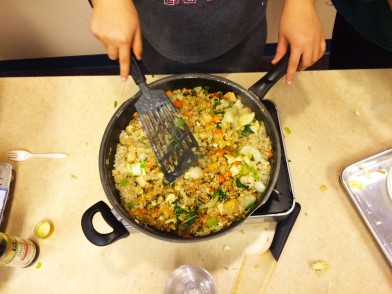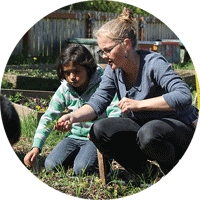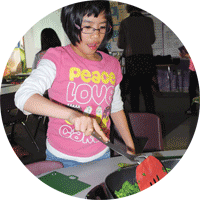On a basic level, we eat to survive – but food is usually so much more than that. It can be a comfort, a social activity and even a pastime.

Cooking Matters students each got a chance to work over the stove, scrambling eggs and making fried rice.
At a recent cooking and nutrition class held by Solid Ground’s Cooking Matters program, this was the topic of the nutrition lesson: to be mindful of what we eat and why we eat it. Cooking Matters hosts 6-week classes for people of all ages throughout the year, but this particular class was for families with children in middle school.
Cooking Matters, part of the national Share our Strength’s No Kid Hungry campaign, teaches families and children how to buy and cook healthy food on a budget. The goal is not only to teach, but also to provide a space for participants to share experiences and information. Cooking Matters Program Coordinator Nicole Dufva says, “We try to foster a dialogue about what it means to eat healthy for each person.”
In the area, Cooking Matters partners with up to 60 community organizations to host and teach classes. The recent class for families with middle schoolers was a satellite program at Odessa Brown Children’s Clinic, run by the nutritionist at the clinic, Rebecca Finkel.
Though it’s the satellite program’s 8th year, this was Rebecca’s first time teaching a class specifically for families with middle schoolers. Before, the clinic hosted classes for families with children ages 8-13. This change was made in response to parent comments, suggesting that working with peer groups is more productive and fun for their children.
Rebecca explains that middle schoolers are old enough to do more actual cooking than younger children, so “it’s a good time for them to gain basic skills and nutrition awareness so that if their parents are at work or away, they can make something easy and healthy to eat.”
After the nutrition lesson, the kids practiced cracking, scrambling and frying eggs to use in the main dish, fried rice with tofu. Meanwhile, the parents sat down to talk with Rebecca.
Rebecca explains that parents’ participation is equally important for this age group, because the parents are responsible for “setting the food environment.” In other words, parents are responsible for the food that is available if their children want to make food for themselves.
“The food environment also determines the rules around eating together,” says Rebecca. “Is the TV on during the meal? Are screens allowed during the meal? What do they discuss at the table?” The parent group discusses changes that could be made in the household to create a healthier lifestyle, including cooking together, getting more exercise or eating meals together.
On the 5th week of each class, the group travels to a local grocery store to practice shopping for nutritious food on a budget. Many families may consider fresh produce to be too expensive, so Cooking Matters emphasizes the health benefits of frozen and canned fruits and vegetables; in general, all classes focus on a plant-based diet.
Besides fried rice with tofu, this group made a delicious mango salsa to snack on during the class. At the end of the night, everyone received a copy of the recipes and a bag of fresh ingredients so that they could enjoy the dishes again at home.
Filed under: Cooking Matters | Tagged: community building, Food & Nutrition, hunger, nutrition education | Leave a comment »




 is the
is the 










